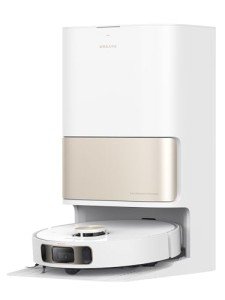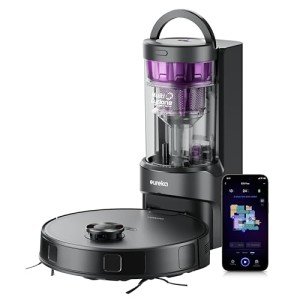This company has no active jobs
0 Review
Rate This Company (0)
Infomation Company
- 0 Jobs
- Company Address Fidel robot vacuum deals black friday GbR
Something About Company
This Is The Ultimate Guide To Robotic Vacuum Cleaner Best
 What Makes a Robot Vacuum Cleaner Best?
What Makes a Robot Vacuum Cleaner Best?
The top robot vacuums come with a a powerful motor and a set of bristles or rollers that are durable. They also have decently sized dustbins and long battery life.
 Certain models map homes using smart mapping, and can pause to recharge and then resume cleaning where they left off. They can create no-go zones, and recognize different surfaces.
Certain models map homes using smart mapping, and can pause to recharge and then resume cleaning where they left off. They can create no-go zones, and recognize different surfaces.
Object Avoidance
Object detection is a crucial feature for robot vacuums since it allows them avoid getting into small objects such as cords, toys, socks or shoes that are not on the floor, but instead on furniture. The systems utilize a built-in camera to recognize objects that appear in an AI database and then instruct the vacuum to avoid them. The Eufy S1 Pro uses a combination of sensors, including 3D Time of Flight, which sends light pulses into the room to gauge the distance and depth of objects and 3D Structured Light, which emits a pattern of light onto the room and analyzes the distortion of light to build a map to avoid obstacles.
A more recent addition to the obstacle avoidance repertoire is artificial intelligence and visual interpretation, which allows robots to better identify and understand what they’re observing. This software utilizes two cameras to view the world and analyze it in real-time. This software is used by ECOVACS DEEBOT to detect up 30 different objects, which includes cables and shoes.
Certain models employ LiDAR for navigation. The technology emits lasers and measures the time taken for them to bounce off the surfaces around them to create an 3D map. This is useful in the detection of furniture, walls and even stairs. However, it might not work as well in dim lighting or when working with transparent or reflective objects.
No matter what sensors or cameras are utilized regardless of the camera or sensor used, a long-lasting battery is crucial to ensure that your robot will be able to complete an entire home without the need to return to its dock to recharge. Select a model that has an extended battery life of at least 80 minutes, or longer depending on the dimensions and layout of your home.
Self-Emptying Bases
Some robot vacuum cleaners come with self-emptying bases that can reduce the frequency with which you must empty your bin. They’re considered to be a luxury feature and typically add to the overall price of a robot.
The most effective robots have bases that can hold a bin, or a dust bin that is removable. You can open the bin and empty it when full. This will save you time by decreasing the amount of time you spend worrying about the time to empty a bin.
You’ll find self-emptying bases on all the robots in our review, with the exception of the bare-bones Roomba I3+, which doesn’t have one. This is a shame since the robot performs extremely well. It had the best mapping results of all the robots we tested and it has superb navigation capabilities. It also has good mowing power and a docking station that automatically empty the water tank if needed.
It doesn’t have iRobot’s advanced obstacle avoidance system and digital keep-out zone, but it can get tangled up in cables and rugs, and is unable to see the stray shoelaces or socks. However, it’s an excellent choice for a small, well-maintained house.
Other strengths are its navigation system, which includes bump sensors as well as a drop sensor, and the ability to make your home a map by using lasers and cameras. It’s also simple to set up, has many settings and modes, and also offers an excellent performance in mowing and vacuuming. Another advantage is its smart-home connectivity, which enables it to work with voice commands via Amazon Alexa and Google Assistant. This makes it easier to use if have multiple tablets or smartphones and don’t want to grab an additional remote.
App Controls
Some robots connect to Wi-Fi. This allows you to control them with your tablet or smartphone. This is particularly beneficial in large homes that have multiple floors. You may need to navigate down an escalator to reach the robot before it can reach the bottom. This eliminates the need for an additional long cord to move furniture without worrying about the robot getting caught in it or running out of power when cleaning.
The app acts as a one-stop control center to monitor and schedule tasks. The app lets you customize the power, cleaning mode and the water level of your robotic cleaner. This feature is particularly useful inside homes that have multiple floor types — for example, carpet and tile — because you can assign the robot to clean each room with the correct power and mode.
Certain models come with an integrated video camera that transmits a live feed directly to the application. These models are great for pet owners as well as those with children who need to keep an eye on the robot as it operates. Other smart robots have sensors that can detect when they’ve reached the edge of a room. They then return to their base to dock. This stops them from sweeping over the area and also ensures that they’ve cleaned all of the surfaces in your home.
Certain models are able to automatically empty the dustbin, and blow dry and wash its mop heads in between cleaning sessions. This minimizes the frequency of manual maintenance and helps keep the cleaner in good working order for a longer time. You can also choose models with an extended battery, which helps you avoid the hassle of mid-cleaning recharges.
Sensors
Many robot vacuums make use of sensors to navigate your home and work their magic on hard floors like laminate, tile, and wood as also low pile carpets and area rugs. They’re not a substitute to an upright or full-size cleaner, but offer excellent suction and a fantastic way to keep your floors clean in between deep cleanings.
Sensors enable the robot to navigate around your home by detecting obstacles and avoiding falling on the stairs. They also let you set virtual and physical “no-go” zones using a feature called boundary strips or virtual walls (like the ones used by Eufy) to stop the robot from entering certain areas of your home. Some robots also come with cliff sensors, which warn you when the robot is close to crossing an edge.
The type of navigation system the robot utilizes will depend on your budget and the layout of your home. The most advanced robotic vacuums use LiDAR-based sensors to map and scan rooms, which ensures accurate and efficient navigation. These systems are expensive but provide the best results. Budget-friendly models with rudimentary bump navigation systems aren’t as precise and could miss some spots. They’re great for avoiding big obstacles, but they could still be unable to detect dirt in crevices or around baseboards.
Find a model that has an extra-large dust container and an extended battery life. You can also find models that recharge and then resume where they left off when they dock to save time. You can maximize the use of your robot vacuum in addition to navigation, by prepping each cleaning session. Check that all power cords as well as toys and other debris are tucked away and away from the robot’s path, and empty the bin between each cleaning. Cleanse the sensors and charging port to ensure your robot is in good health.
Navigation
The most effective robot vacuums create a digital mapping of your home with mapping technology during the initial cleaning session. It allows them to recognize different the different textures, like carpets and hard floors, and ensures that all areas are thoroughly cleaned. Mapping also saves your robot from re-cleaning the same spots that improves efficiency and can reduce battery usage. A majority of top models let you save maps to use in the future. This is great for large homes.
Most robotic vacs have some kind of obstacle avoidance that keeps them from crashing into cords, shoes, or socks. These sensors are not always able to detect small objects. Some time ago manufacturers began adding additional sensors to their robots, allowing them detect and avoid household objects that standard sensor systems couldn’t. These include cliff sensors as well as wall sensors that operate by reflecting infrared beams light off surfaces to determine distances.
Some of these sensors are integrated into the robot’s base, while others require you to purchase a separate attachment. These sensors generally help the robot navigate in a safe manner and avoid falling down steps, and stay clear of clutter. Certain models have anti-drop sensors which prevent the robot from colliding with furniture and walls.
LiDAR mapping is the newest and most advanced technology for navigation, and it’s something you should look for in the robot vacuum. This kind of system makes use of the spinning laser sensor that is placed on the top of the robot in order to map your home. It can map your home’s layout by bouncing infrared rays off your walls and furniture. This information can help it plan efficient paths and clear your entire house.

